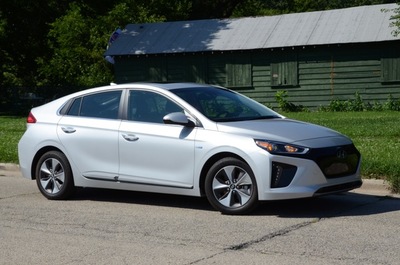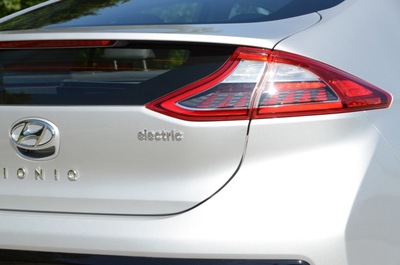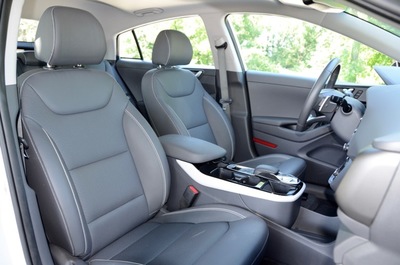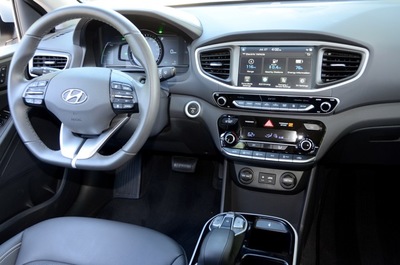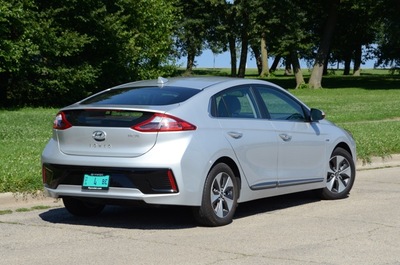2017 Hyundai Ioniq Electric
The new green model line
By Larry Nutson
Senior Editor and Bureau Chief
Chicago Bureau
The Auto Channel
There’s been a lot of hoopla of late about electric cars. It seems every carmaker is getting into the game. Even luxury automakers like Porsche and Aston Martin.
The most recent “jolt” in the EV market was with Tesla’s first few production examples of its $35,000 Model 3 rolling off the production line. Actually, the first few Model 3s are optioned-up and cost more like $44,000. Production volume is low right now with significant availability not expected until some time in 2018.
One of the other newcomers to the EV car market, one that you can buy right now, is the 2017 Hyundai Ionic Electric. The Ioniq Electric is a compact, four-door, 5- passenger hatchback nicely priced at $29,500 (before any possible federal or state incentives).
Hyundai says the Ioniq is “the most efficient electric vehicle sold in America.” Its estimated driving range is 124 miles. EPA MPGe ratings are 136 MPGe combined, with 150 city MPGe and 122 highway MPGe.
How’s this pretty substantial driving range possible—better batteries.
I’ve driven the BMW i3, Chevy Bolt EV, Ford Focus EV, Kia Soul EV, Nissan Leaf EV, Mitsubishi iMEV, Smart EV and VW eGolf EV. (I think that’s all of them.) I can remember my first experience sitting behind the wheel of an EV with the instrument display telling me I had 60 miles to empty—and that was with a fully charged battery. If I had been in a traditional gasoline-engine car I would have headed right to the gas station.
Today’s new batch of EVs are real cars. They perform very well. They accelerate relatively quickly as a result of the high torque of the electric motor that is available immediately from stop. The two drawbacks to an EV are driving range, which gives us range anxiety, and a long battery charging time. But, things are improving.
The big problem we still have is an inadequate public infrastructure of charging stations. The auto industry spent the first decade of this century developing and perfecting the electrification of vehicles, whether they be pure EVs or hybrids. What was supposed, or expected, to happen in this second decade was the expansion of charging infrastructure in large cities and across the country. That happened to a certain extent in the early 2010s but then slowed due to the ongoing low gasoline price and the consequential lack of interest in electrified vehicles.
So put this all aside for the moment. Let’s look at the Ioniq Electric. A fully discharged battery in the Ioniq can be recharged with a level 2, 220/240V charger in 4 hours and 25 minutes. There’s plenty of time overnight at home for that. Or, when at your work that’s half a day.
All Ioniq Electric models are equipped with standard Level-3 DC fast-charging capability. Charging the Ioniq Electric’s battery up to 80 percent only takes approximately 23 minutes using a SAE Combo Level-3 DC, 100 kW fast charger. Think about that. That’s the same time it takes to stop and fill the gas tank, go to the restroom and get a coffee.
Charging on 110/120 v house current can be done, but I don’t recommend that this be the usual method. It takes a long time. I personally believe any EV owner who uses his car daily needs a level 2 charger where they park overnight.
I should point out that the Ioniq, like all EVs, is equipped with regenerative braking which maintains a steady state of charge in the battery. It’s like making fuel while you slow down. Driving around Chicago with its frequent stop signs and red lights I hardly lost any driving range since the battery was always being recharged while on the go. The level of regenerative braking can be controlled with a driver-operated paddle.
The Ioniq Electric has a 28 kWh lithium-ion polymer battery and an electric motor with a maximum output of 88 kW (118 horsepower) and 218 lb.-ft. of torque mated to a single-speed reduction-gear transmission.
In the cockpit the Ioniq offers all the comfort and convenience features that buyers expect in a car today. The transmission uses a shift-by-wire push-button drive selector. The Ioniq also features an electronic parking brake, conserving space in the center console.
To save on battery charge, the Ioniq climate control can be switched to an efficient operation mode that maximizes air recirculation. There’s also a ‘Driver only’ mode that reduces the load of both air conditioning and heating on the overall powertrain.
Ioniq has a 7-inch touch screen display and connectivity features include Apple CarPlay, Android Auto and Blue Link, as well as wireless charging for smartphones
Driver-assistance safety features that are available include Automatic Emergency Braking with Pedestrian Detection, Lane Departure Warning, Blind Spot Detection and Rear Cross-Traffic Alert, and a rear view camera.
There’s a 60/40 split-fold rear seat with a spacious 23.8 cu.ft. of cargo space behind it.
The base model Ioniq Electric is priced at $29,500 and the Limited model is $32,500. An optional $3,500 Ultimate Package on the Limited includes a power sunroof, smart cruise control with stop, navigation, 8-speaker Infinity Premium audio, automatic emergency braking, lane departure warning and a few more items.
2017 Hyundai Ioniq Electric Review By Larry Nutson
The 2017 Ioniq is also available as a Hybrid priced starting at $22,200 and added now for 2018 as a Plug-in hybrid. Links to in-depth and complete details and specifications for every Ioniq model can be found at the bottom of this article or go to www.hyundaiusa.com.
In considering an EV, your main driving patterns as well as overnight parking and the ability to recharge need be given serious thought. With its 124 miles of driving range on a fully charged battery, the Ioniq will go farther than most rival EVs.
For me as a city dweller, the Ioniq would fit in very well for most all my reoccurring annual driving needs. The futurists say more and more of us, both older and younger, will be living in cities. EVs make sense with their zero emissions. Oh, did I mention there’s no engine or exhaust noise either.
The one shortcoming today is long road trips. An often-made 250-mile drive east from Chicago would require that I get a rental car for that. When we someday have level 3 quick-charge stations at interstate rest areas that may change. I hope at that time the wait line for a quick charge isn’t too long.
The “sound of silence” is upon us.
© 2017 Larry Nutson, the Chicago Car Guy




